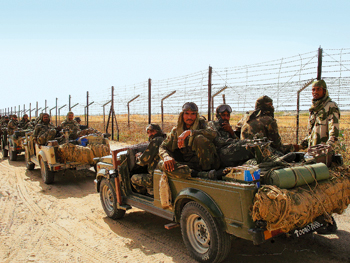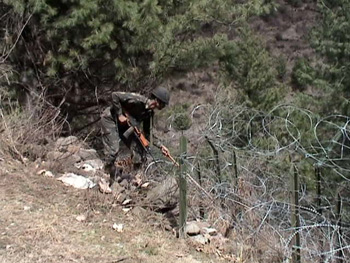INDIAN ARMED FORCES CHIEFS ON
OUR RELENTLESS AND FOCUSED PUBLISHING EFFORTS

SP Guide Publications puts forth a well compiled articulation of issues, pursuits and accomplishments of the Indian Army, over the years

I am confident that SP Guide Publications would continue to inform, inspire and influence.

My compliments to SP Guide Publications for informative and credible reportage on contemporary aerospace issues over the past six decades.
- Interim Defence Budget 2024-25 — An Analysis
- Union Defence budget 2024
- Indian Army: In quest of greater firepower and policy recommendations for gaps
- Indian Army Annual Press Conference 2024
- 6G will transform military-industrial applications
- Tata Boeing Aerospace Delivers 250 AH-64 Apache Fuselages, Manufactured in India
Fencing Borders
 |
By Lt. General P.C. Katoch (Retd) Former Director General of Information Systems, Indian Army |


By all indications Pakistan is hell bent to increase terrorist attacks in India and make all out efforts to continue infiltrations both through the LoC and IB sectors. The withdrawal of US-NATO forces from Afghanistan has given the opportunity to the Pakistani military to establish its much cherished strategic depth in Afghanistan, which Robert Kaplan in his book 'The Revenge of Geography' describes as, "An Afghanistan that falls to Taliban sway threatens to create a succession of radicalized Islamic societies from the Indian-Pakistani border to Central Asia. This would, in effect, a greater Pakistan, giving Pakistan's ISI the ability to create a clandestine empire composed of the likes of Jallaluddin Haqqani, Gulbuddin Hekmetyar, and the Lashkar-e-Taiba : able to confront India in the manner that Hezbollah and Hamas confront Israel". The Pakistani military establishment is further buoyed by China's US$ 47 billion China-Pakistan Economic Corridor (CPEC) coming up close to the Indo-Pak border and presence of PLA personnel in garb of workers and technicians in development projects, plus silos being dug by Chinese in Gilgit-Baltistan under cover of hydel projects to deploy missiles. Infiltration is comparatively easier in J&K because of rugged terrain.
India has erected border fencing in J&K in high threat areas but gaps between posts can only be covered through patrolling or ambushes which spreads the security forces thin on the ground and is not 100 percent foolproof despite best efforts especially in hours of darkness, fog and adverse weather. Pakistan has been employing heavy cross-border firing to assist infiltration and terrorists have also been using explosives to make gaps in the fencing or dig holes under the fence. In addition, heavy snows bury the fence especially in north Kashmir and large portions are also destroyed annually because of avalanches. Some 350-400 km of fencing in J&K gets damaged every winter and has to be repaired or replaced during summer. Now the Army has reportedly finalized plans to construct a new type of fence on the LoC, which will not collapse due to heavy snowfall every winter. The new design has been arrived at after winter trials and work to erect the fencing is likely to commence within this year. Before the onset of winters last year, the Army tried three new designs of the fence; one provided by the Snow and Avalanche Study Establishment (SASE) and two prepared in-house by the Army. Testing was done by constructing one-km long sample fences in Kupwara sector. In the new design, strong, circular pole are used instead of traditional iron picket. Also, anew new type of concertina coil is used that has a double-twisted galvanized mesh added to either side. The design is modular, which makes it easier to carry the stores, and to construct and repair the fence.
The new design will reportedly have night-vision cameras, alarms and visual map displays integrated with the fence, all of which will be linked to a monitoring room, giving the local military commanders real-time data enabling quick reaction against any attempt to tamper with the fence. The fence is also proposed to be lit up using LED lighting where feasible. Existing fence in Jammu Sector is already lighted. While the construction would begin by the Army, for overall construction and maintenance of the fence, the government has sanctioned three new Territorial Army Engineer battalions for Northern Command. Soldiers for these units have already been recruited and the first lot, which is currently undergoing training, will be available by March next year. At the same time, damage to the fence, both old and new, from the home side to assist infiltration too needs to be examined and due measures instituted considering the spurt in terrorist recruitment within J&K as being shown on national TV through propaganda videos of terrorists. At the same time, infiltration terrorists will continue to use explosives. Minefields along the LoC have become dysfunctional and shifted because of vagaries of weather over the years. It is not advisable to mile the entire border but certainly the routine patrols could affix and keep beefing IEDs along the fence particularly at likely infiltration points. A few infiltrating terrorists blowing up their limbs would add to the deterrence value of the fence. The possibility of creating a 1-2 km no man land own side of the border by relocating the houses in this zone and shooting anything that moves within, is an idea that has been discussed in passing in the past. With enough land in J&K, this needs to be seriously considered and implemented in phased manner.





